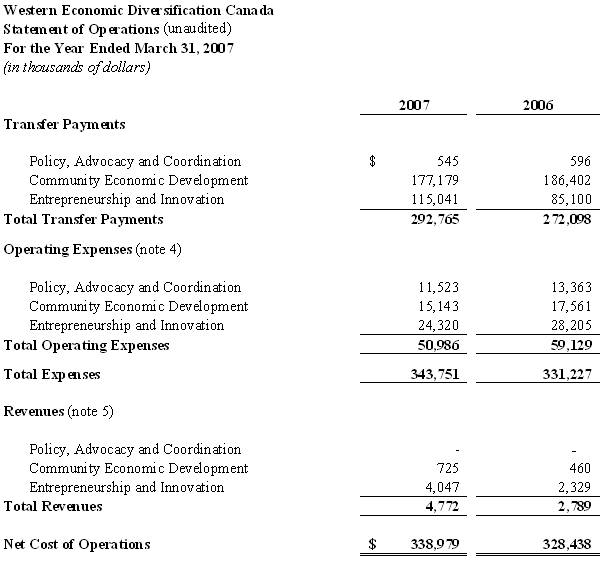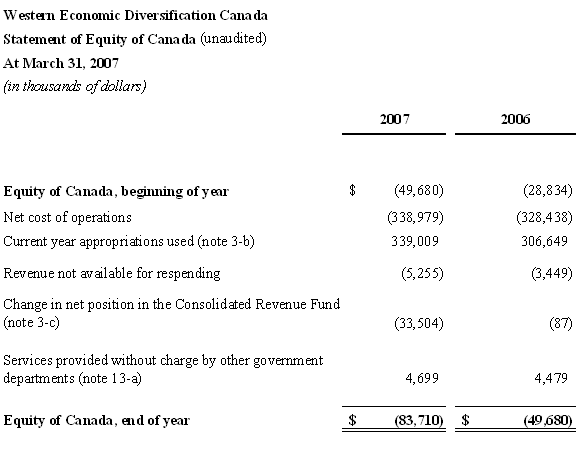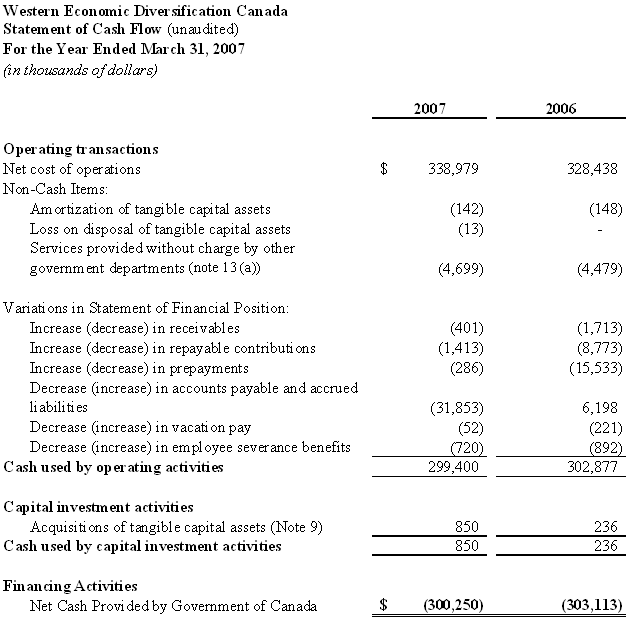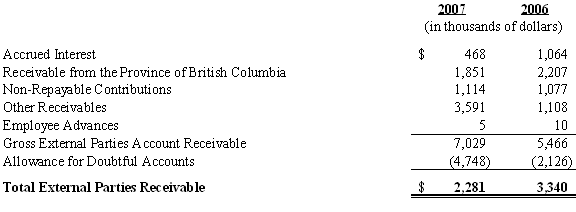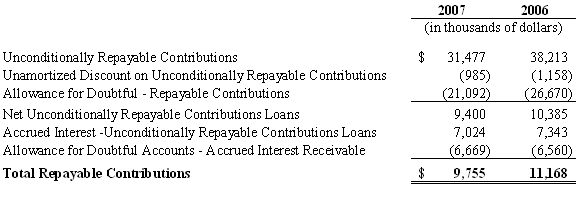Common menu bar links
Breadcrumb Trail
ARCHIVED - Western Economic Diversification Canada
 This page has been archived.
This page has been archived.
Archived Content
Information identified as archived on the Web is for reference, research or recordkeeping purposes. It has not been altered or updated after the date of archiving. Web pages that are archived on the Web are not subject to the Government of Canada Web Standards. As per the Communications Policy of the Government of Canada, you can request alternate formats on the "Contact Us" page.
ANNEX I: Financial Statements
Western Economic Diversification Canada
Financial Statements (Unaudited)
For the year ended March 31, 2007
Western Economic Diversification Canada
Statement of Management Responsibility
Responsibility for the integrity and objectivity of the accompanying financial statements for the year ended March 31, 2007, and all information contained in this report rests with Western Economic Diversification Canada (WD) management. These financial statements have been prepared by management in accordance with accounting standards issued by the Treasury Board of Canada Secretariat which are consistent with Canadian generally accepted accounting principles for the public sector.
Management is responsible for the integrity and objectivity of the information in these financial statements. Some of the information in the financial statements is based on management’s best estimates and judgement and gives due consideration to materiality. To fulfil its accounting and reporting responsibilities, management maintains a set of accounts that provide a centralized record of the Department’s financial transactions. Financial information submitted to the Public Accounts of Canada and included in the WD’s Departmental Performance Report is consistent with these financial statements.
Management maintains a system of financial management and internal control designed to provide reasonable assurance that financial information is reliable, that assets are safeguarded and that transactions are in accordance with the Financial Administration Act are executed in accordance with prescribed regulations, within Parliamentary authorities, and are properly recorded to maintain accountability of Government funds. Management also seeks to ensure the objectivity and integrity of data in its financial statements by careful selection, training and development of qualified staff, by organizational arrangements that provide appropriate divisions of responsibility, and by communication programs aimed at ensuring that regulations, policies, standards and managerial authorities are understood throughout the Department.
Management is supported by the Departmental Audit and Evaluation Committee. This Committee approves the departmental audit and evaluation plan and oversees the internal audit and evaluation activities in the Department. It also reviews the results of audits and evaluations as well as management responses and action plans developed to address audit or evaluation recommendations.
The financial statements of Western Economic Diversification Canada have not been audited.
 |
 |
|
| Oryssia J. Lennie Deputy Minister Edmonton, Alberta Canada |
Jim Saunderson Senior Financial Officer Edmonton, Alberta Canada |
|
 |
|
 |
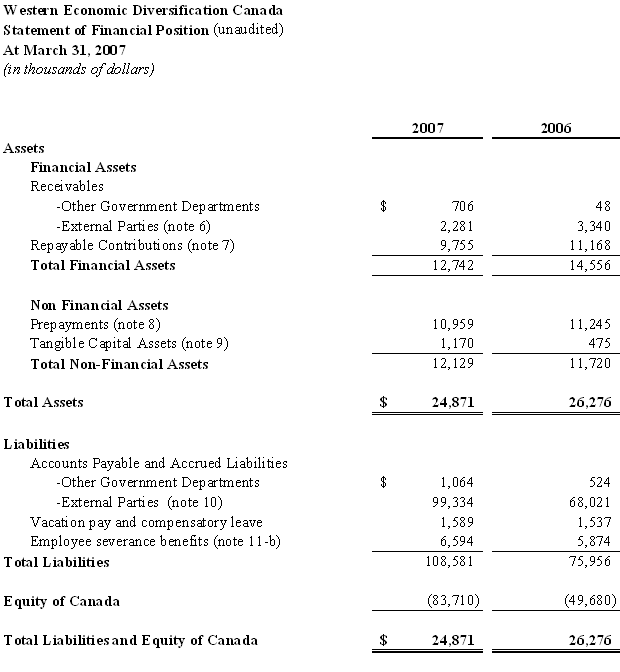
Click on image to enlarge
Commitments (Note 12)
Western Economic Diversification Canada
Notes to the Financial Statements (Unaudited)
For the Year Ended March 31, 2007
1. Authority and Objectives
Western Economic Diversification Canada (WD), a department of the Government of Canada operates under the authority of the Western Economic Diversification Act of 1988 that works to strengthen Western Canada's economy and advance its interests in national economic policy.
Through the Act, WD is mandated to:
|
Working in partnership with provincial and municipal governments, as well as other organizations, WD’s programs and initiatives contribute to the Government of Canada’s agenda for building a 21st Century economy in the West.
WD’s headquarters and Deputy Minister are located in Edmonton, Alberta. In close cooperation with western stakeholders, WD’s objective is to more effectively guide federal government policies, regulations and resources so that they become more constructive instruments of western economic growth and diversification. WD’s efforts are concentrated in three distinct but interrelated areas leading to the following strategic outcomes:
- policies and programs that support the development of Western Canada
(Policy, Advocacy & Coordination);
- economically viable communities in Western Canada with a high quality of life
(Community Economic Development *); and
- a competitive and expanded business sector in Western Canada and a strengthened western Canadian innovation system (Entrepreneurship and Innovation).
As part of WD’s mandate to co-ordinate federal economic activities in the West, WD implements some programs on behalf of other federal departments and agencies. These programs are implemented under Memoranda of Understanding where the other federal department provides the authorities and funding from Parliament. Related costs are reported in the accounts of other federal departments, they are not reflected as expenses in these Financial Statements.
*Reported in 2005/06 financial statements under the heading of Sustainable Communities.
2. Summary of Significant Accounting Policies
The financial statements have been prepared in accordance with accounting standards issued by the Treasury Board of Canada Secretariat which are consistent with Canadian generally accepted accounting principles for the public sector.
Significant accounting policies are as follows:
- Parliamentary appropriations – WD is financed by the Government of Canada through Parliamentary appropriations. Appropriations provided to WD do not parallel financial reporting according to Canadian generally accepted accounting principles since appropriations are primarily based on cash flow requirements. Consequently, items recognized in the Statement of Operations and the Statement of Financial Position are not necessarily the same as those provided through appropriations from Parliament. Note 3 provides a high-level reconciliation between the two basis of reporting.
- Net Cash Provided by Government – WD operates within the Consolidated Revenue Fund (CRF). The Receiver General for Canada administers the CRF. All cash received by WD is deposited to the CRF and all cash disbursements made by WD are paid from the CRF. Net cash provided by Government is the difference between all cash receipts and all cash disbursements including transactions between departments of the federal government.
- Change in net position in the CRF is the difference between the net cash provided by government and appropriations used in a year, excluding the amount of non-respendable revenues recorded by WD. It results from timing differences between when a transaction affects appropriations and when it is processed through the CRF.
- Revenues
- Revenues from regulatory fees are recognized in the accounts based on the services provided in the year.
- Other revenues are accounted for in the period in which the underlying transaction or event occurred that gave rise to the revenues.
- Sources of revenues include:
- Interest charges on repayment of contributions.
- Sources of revenues include:
- Expenses are recorded on the accrual basis:
- Transfer Payments:
- Grants are recognized in the year in which the conditions for payment are met.
- Contributions are recognized in the year in which the recipient has met the eligibility criteria or fulfilled the terms of a contractual transfer agreement.
- Vacation pay and compensatory leave are expensed as the benefits accrue to employees under their respective terms of employment.
- Services provided without charge by other government departments for accommodation, the employer’s contribution to the health and dental insurance plans, workers’ compensation and legal services are recorded as operating expenses at their estimated cost.
- Transfer Payments:
- Employee future benefits
- Pension benefits: Eligible employees participate in the Public Service Pension Plan (The Public Service Superannuation Act), a multi-employer plan administered by the Government of Canada. WD’s contributions to the plan are charged to expenses in the year incurred and represent the total departmental obligations to the plan. Current legislation does not require WD to make contributions for any actuarial deficiencies of the plan.
- Severance benefits: Employees are entitled to severance benefits under labour contracts or conditions of employment. These benefits are accrued as employees render the services necessary to earn them. The obligation relating to the benefits earned by employees is calculated using information derived from the results of the actuarially determined liability for employee severance benefits for the government as a whole.
- Accounts receivables and advances. These are stated at amounts expected to be ultimately realized; a provision is made for receivable where recovery is considered uncertain.
- Loss Support Contributions and Investment Program - are agreements with financial institutions whereby the financial institutions authorize and issue loans using their own capital, and WD contributes to a loss support contribution, equal to between 10 and 20% of the value of the loans issued. These reserves may be used to offset a portion (up to 80%) of net losses on defaulted loans, but may not exceed WD’s total contribution.
- Transfer Payments are payments that are made on the basis of an appropriation for which no goods or services are directly received (but may require the recipient to provide a report or other information subsequent to receiving payments). WD administers two types of transfer payments:
- Grants: transfer payments made to an individual or organization that is not subject to being accounted for or audited, but for which eligibility and entitlement may be verified or the recipient may need to meet pre-conditions.
- Contributions: conditional transfer payments made to an individual or organization for a specified purpose pursuant to a contribution agreement that is subject to being accounted for and audited.
- Unconditionally repayable contributions are contributions that must be repaid without qualification. Due to their concessionary nature, they are recorded on the Statement of Financial Position as loans at their estimated present value. A portion of the unamortized discount is brought into income each year to reflect the change in the present value of the contributions outstanding. Appropriate allowances for uncollectible amounts are also established based on an individual appraisal of accounts. Interest revenue on outstanding receivables is recognized in the year that they are earned.
- Conditionally repayable contributions are contributions that all or part of which becomes repayable if conditions specified in the contribution agreement come into effect. Accordingly, they are not recorded on the Statement of Financial Position until such time as the conditions specified in the agreement are satisfied at which time they are then recorded as a receivable and a
reduction in transfer payment expenses. Appropriate allowances for uncollectible amounts are also established based on an individual appraisal of accounts.
Prior to 1995 repayable contributions were regularly used to assist in the delivery of WD’s mandate. Since 1995 they have only been used in limited circumstances. However, these repayable contributions will continue to be recorded on the financial statement and will continue to be until they are repaid or all reasonable attempts to collect have been taken and the accounts written-off. - Non-Repayable contributions are contributions that are not repayable unless default conditions in the agreement are exercised.
- Prepayments – WD follows the Treasury Board Transfer Payment Policy, Article 7.6 Cash Management Policy: Instalments of Grants and Advance Payments of Contribution, Section 3 – advance payments are only provided or limited to the immediate cash requirement based on a monthly cash flow forecast from the recipient. Prior to fiscal year 2005-2006 all prepayments were recorded as accounts receivables. Effective April 1, 2005, WD changed its accounting policy for recording these transactions as expenses. For prepayments, the reporting back by a recipient on the use of funds is an administrative requirement and not a determining factor in the recognition of the payment as an expense. Only the portion of a prepayment given to a recipient that is intended to cover expenses to be incurred in a subsequent fiscal year is recorded as an account receivable.
- Contingent liabilities are potential liabilities, which may become actual liabilities when one or more future event(s) occurs or fails to occur. To the extent that the future event is likely to occur or fail to occur, and a reasonable estimate of the loss can be made, an estimated liability is accrued and an expense recorded. If the likelihood is not determinable or an amount cannot be reasonably estimated, the contingent liability is disclosed in the notes to the financial statements. WD has no contingent liabilities at this time.
- Tangible capital assets (note 9) – All tangible assets and leasehold improvements having an initial cost of $10,000 or more are recorded at their acquisition cost. WD does not capitalize intangibles, works of art and historical treasures that have cultural, aesthetic or historical value.
Amortization of tangible capital assets is done on a straight-line basis over the estimated useful life of the asset as follows:
Asset class
Sub-asset class
Amortization period
Machinery and equipment
Computer equipment
3 years
Computer software
3 - 7 years
Other equipment
10 years
Vehicles
5 years
Leasehold improvements
Term of the lease
The amortization period for computer software has been modified this fiscal year to reflect a change in the accounting treatment for the purchase of “off the shelf “software (amortized over 3 years) and in-house developed software (amortized up to 7 years).
- Measurement uncertainty – The preparation of these financial statements in accordance with accounting standards issued by the Treasury Board of Canada Secretariat which are consistent with Canadian generally accepted accounting principles for the public sector requires management to make estimates and assumptions that affect the reported amounts of assets, liabilities, revenues and expenses reported in the financial statements. At the time of preparation of these statements, management believes the estimates and assumptions to be reasonable. The most significant items where estimates are used are the liability for employee severance benefits, the useful life of tangible capital assets and unamortized discount related to unconditionally repayable contributions. Actual results could differ from those estimated. Management’s estimates are reviewed periodically and, as adjustments become necessary, they are recorded in the financial statements in the year they become known.
3. Parliamentary Appropriations
WD receives most of its funding through annual Parliamentary appropriations. Items recognized in the Statement of Operations and the Statement of Financial Position in one year may be funded through Parliamentary appropriations in prior, current or future years. Accordingly, WD has different net cost of operations for the year on a government-funding basis than on an accrual accounting basis. The differences between net cost of operations and appropriations are reconciled in the following tables.
(a) Reconciliation of net cost of operations to current year appropriations used:
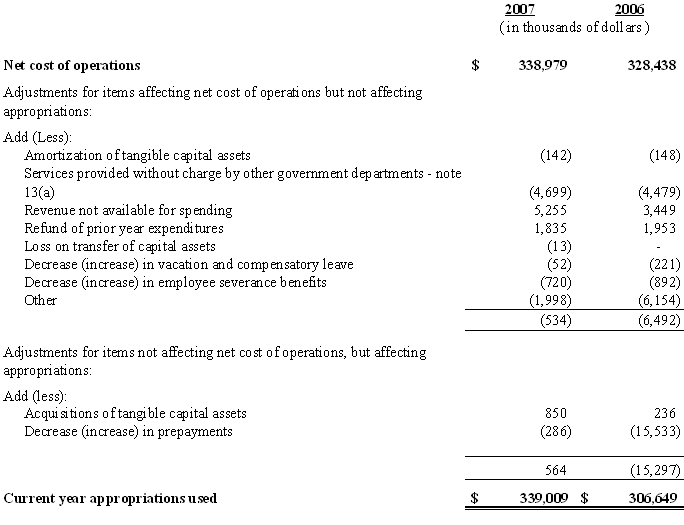
Click on image to enlarge
(b) Appropriations provided and used:
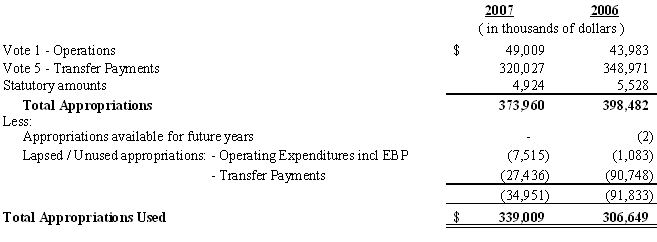
Click on image to enlarge
(c) Reconciliation of net cash provided by Government of Canada to current year appropriations used:
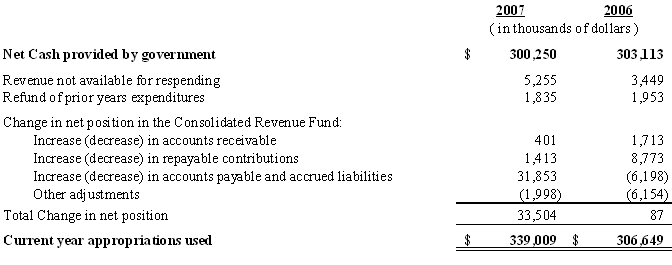
Click on image to enlarge
4. Expenses
The following table presents details of expenses by category:
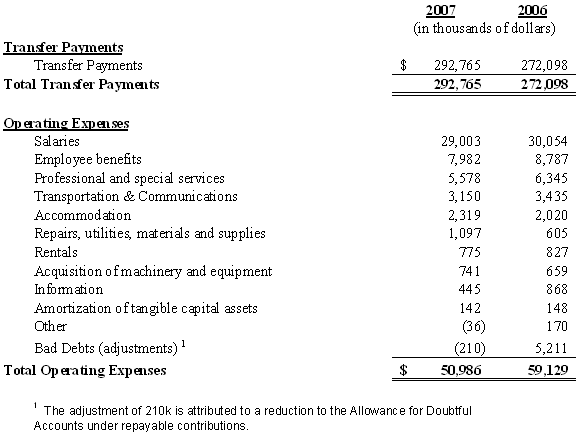
Click on image to enlarge
5. Revenues
The following table presents details of revenues by category:

Click on image to enlarge
6. Accounts Receivable – External Parties
7. Accounts Receivable – Repayable Contributions
8. Prepayments
9. Tangible Capital Assets
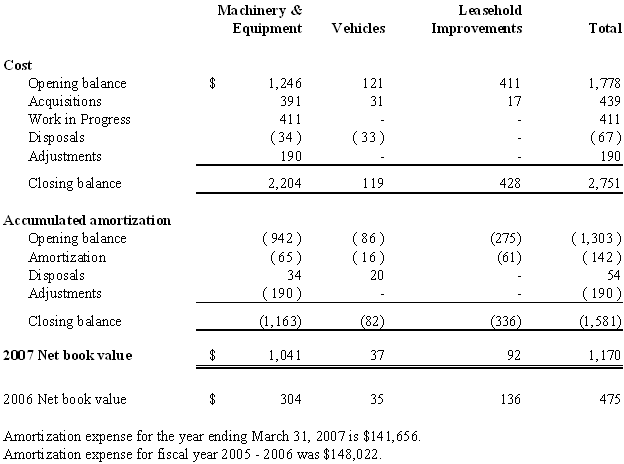
Click on image to enlarge
(in thousands of dollars)
10. Accounts Payable and Accrued Liabilities – External Parties
11. Pension and Severance Benefits
- Pension benefits: WD’s employees participate in the Public Service Pension Plan, which is sponsored and administered by the Government of Canada. Pension benefits accrue up to a maximum period of 35 years at a rate of 2 percent per year of pensionable service, times the average of the best five consecutive years of earnings. The benefits are integrated with Canada/Qu�bec Pension
Plans benefits and they are indexed to inflation.
Both the employees and WD contribute to the cost of the Plan. The 2006-07 expense amounts to $3,624,004, ($4,029,282 in 2005-06), which represents approximately 2.2 times (2.6 in 2005-06) the contributions by employees.
WD’s responsibility with regard to the plan is limited to its contributions. Actuarial surpluses or deficiencies are recognized in the financial statements of the Government of Canada, as the plan’s sponsor.
- Severance benefits: WD provides severance benefits to its employees based on eligibility, years of service and final salary. These severance benefits are not pre-funded. Benefits will be paid from future appropriations. Information about the severance benefits, measured as at March 31, is as follows:
12. Commitments
The nature of the WD’s activities can result in some large multi-year contracts and obligations, whereby WD will be obligated to make future payments when the conditions under the agreement are met. Significant commitments that can be reasonably estimated are summarized as follows:

Click on image to enlarge
13. Related party transactions
WD is related as a result of common ownership to all Government of Canada departments, agencies and Crown corporations. WD enters into transactions with these entities in the normal course of business and on normal trade terms. Also, during the year, WD received services, which were obtained without charge from other Government departments as presented in part (a).
- Services provided without charge:
During the 2006-07 fiscal year, WD received without charge from other departments, accommodation services, legal fees, workers’ compensation and the employer’s contribution to the health and dental insurance plans. These services without charge have been recognized in WD’s Statement of Operations as follows:
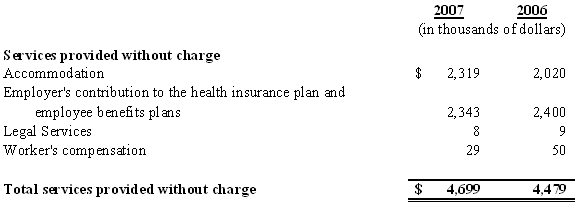
Click on image to enlarge
The government has structured some of its administrative activities for efficiency and cost-effectiveness purposes so that one department performs these on behalf of all without charge. The costs of these services, which include payroll and cheque issuance services provided by Public Works and Government Services Canada, are not included as an expense in the WD’s Statement of Operations.
- Administration of programs on behalf of other government departments.
Part of WD’s mandate is to coordinate federal economic activities in the West. In this regard, WD implements programs on behalf of other federal departments and agencies. The following is a list of programs valued at greater than one million dollars in federal contributions administered by WD over the last two fiscal years. These expenses are reflected in the financial statements of the other government departments and not those of WD.
14. Comparative Information
Comparative figures have been reclassified to conform to the current year's presentation.
1 Total Authorities are greater than Planned Spending as new funding was received through Supplementary Estimates ($19.7 million). This consisted of a $15.0 million grant for Primrose Lake Air Weapons Range, a $2.0 million grant for the Fraser River Port Authority, a $2.5 million contribution transfer for Britannia Mines, a reduction of $2.1 million related to Social Economy and $2.3 million for various other items.
2 Actual Spending is lower than Total Authorities, primarily due to the transfer of contractual commitments under the Infrastructure Canada Program and the Alberta & Saskatchewan Centenaries Initiative to future years.
3 Includes funding approved through both Core and Non-Core Programs.
4 Variance between Planned Spending and Total Authorities is primarily due to the $29M grant for the Prince Rupert Port Authority that was originally reported as planned spending against the Community Economic Planning, Development and Adjustment program activity.
5This includes advisory, information, and training services provided by CFDCs, WEI organizations, FEDOs and CBSCs (officer-assisted interactions only) – 608,027 services in total.
6 This total includes the renewal of 36 CFDC five-year contribution agreements primarily in BC, totalling $41.5 million.
7 http://www.ic.gc.ca/cmb/welcomeic.nsf/532340a8523f33718525649d006b119d/4727bc553ab0c3a785257347006332a7!OpenDocument
8Includes rural Entrepreneur with Disabilities Program loans.
9 Total Authorities are lower than Planned Spending as the $29M grant for the Prince Rupert Port Authority was reflected as planned against the Community Economic Planning, Development and Adjustment program activity instead of the Business Development and Entrepreneurship program activity. During the fiscal year, WD received a further $15M grant, through Supplementary Estimates B, for the Primrose Lake Air Weapons Range, which is included in the Authorities.
10 http://www.chamber.ca/cmslib/general/CLC082005.pdf
11 In Saskatchewan and Manitoba, Aboriginal peoples represent almost 15 per cent of the population, and the numbers are growing three times faster than the general population.
12 WD delivered SICEAI in British Columbia on behalf of Industry Canada through an Other Government Department suspense account. The evaluation report is available at: http://www.ic.gc.ca/epic/site/ic1.nsf/en/h_00142e.html - Audit.
13 Planned and actual spending does not include G&C resources administered by WD on behalf of Infrastructure Canada (MRIF, CSIF), who reports this amount (approx. $127.6 million in actual spending).
14 Actual spending is lower than planned due to the transfer of contractual commitments to future years.
15 As of March 31, 2007, 72 per cent of approved ICP projects were completed and had reported benefits, representing 43 per cent of approved funding. Also, the first three benefits listed arise from the Green Infrastructure sub-activity, the fourth benefit arises from the Local Transportation sub-activity, and the final benefit arises from the Other Infrastructure sub-activity.
16 The negative variance between Authorities and Actual Spending of $602,000 is covered by the surplus variance against the Research and Analysis program activity.
17 This represents the final amount expended; the original amount approved by WD was $220,265.

